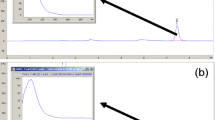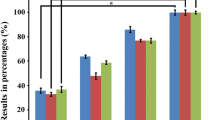Abstract
Melamine belongs to the s-triazine family, and industrially used as raw product in many ways all over the world. Melamine has been reported for human harmful effects and detected from some crops, soil and water. To remove melamine from the polluted environment, the efficient melamine-mineralizing microorganisms have been needed. We newly isolated three melamine-degrading bacteria from the same upland soil sample using soil–charcoal perfusion method. These bacteria were classified as Arthrobacter sp. MCO, Arthrobacter sp. CSP and Microbacterium sp. ZEL by 16S rRNA genes sequencing analysis. Both Arthrobacter species completely degraded melamine within 2 days, and consumed melamine as a sole nitrogen source. Both strains also grew in cyanuric acid as sole nitrogen source, and released small quantities of ammonium ions. These strains are the first identified bacteria that can mineralize both melamine and cyanuric acid as sole initial nitrogen source in Arthrobacter sp. Although ammeline and ammelide intermediates were detected, these strains possess none of the known genes encoding melamine degrading enzymes. Since the Arthrobacter strains also degraded melamine in a high pH liquid medium, they present as potential bioremediation agents in melamine-polluted environments.






Similar content being viewed by others
References
Busse HJ, Wieser M, Buczolits S (2005) Bergey’s Manual of Systematic Bacteriology, Part A, vol 5, 2nd edn. Springer, New York, pp 578–624
De Paolis MR, Lippi D, Guerriero E, Polcaro CM, Donati E (2013) Biodegradation of α-, β-, and γ-hexachlorocyclohexane by Arthrobacter fluorescens and Arthrobacter giacomelloi. Appl Biochem Biotechnol 170(3):514–524
Dobson RLM, Motlagh S, Quijano M, Cambron RT, Baker TR, Pullen AM, Regg BT, igalow-Kern AS, Vennard T, Fix A, Reimschuessel R, Overmann G, Shan Y, Daston GP (2008) Identification and characterization of toxicity of contaminants in pet food leading to an outbreak of renal toxicity in cats and dogs. Toxicol Sci 106:251–262
Dodge GA, Wackett PL, Sadowsky JM (2012) Plasmid localization and organization of melamine degradation genes in Rhodococcus sp. strain Mel. Appl Environ Microbiol 78(5):1397–1403
El-Sayed WS, El-Baz AF, Othman AM (2006) Biodegradation of melamine formaldehyde by Micrococcus sp. strain MF-1 isolated from aminoplastic wastewater effluent. Int Biodeterior Biodegrad 57:75–81
FDA (2008) Interim safety and risk assessment of melamine and its analogues in food for humans, September 12, 2008, http://www.fda.gov/NewsEvents/Newsroom/PressAnnouncements/2008/ucm116947.htm
Iwasaki A, Takagi K, Yoshioka Y, Fujii K, Kojima Y, Harada N (2007) Isolation and characterization of a novel simazinedegrading β-proteobacterium and detection of genes encoding s-triazine-degrading enzymes. Pest Manag Sci 268:261–268
Jain RK, Dreisbach JH, Spain JC (1994) Biodegradation of p-nitrophenol via 1,2,4-benzenetriol by an Arthrobacter sp. Appl Microbiol Biotechnol 60(8):3030–3032
Marshall SJ, White GF (2001) Complete denitration of nitroglycerin by bacteria isolated from a washwater soakaway. Appl Environ Microbiol 67(6):2622–2626
Qin Y, Lv X, Li J, Qi G, Diao Q, Liu G, Xue M, Wang J, Tong J, Zhang L, Zhang K (2010) Assessment of melamine contamination in crop, soil and water in China and risks of melamine accumulation in animal tissues and products. Environ Int 36:446–452
Sakakibara F, Takagi K, Kataoka R, Kiyota H, Sato Y, Okada S (2011) Isolation and identification of dieldrin-degrading Pseudonocardia sp. strain KSF27 using a soil-charcoal perfusion method with aldrin trans-diol as a structural analog of dieldrin. Biochem Biophys Res Commun 411(1):76–81
Seffernick JL, De Souza ML, Sadowsky MJ, Wackett LP (2001) Melamine deaminase and atrazine chlorohydrolase: 98 percent identical but functionally different. J Bacteriol 183:2405–2410
Shao ZQ, Seffens W, Mulbry W, Behki RM (1995) Cloning and expression of the s-triazine hydrolase gene (trzA) from Rhodococcus corallinus and development of Rhodococcus recombinant strains capable of dealkylating and dechlorinating the herbicide atrazine. J Bacteriol 177(20):5748–5755
Shelton DR, Karns JS, Mccarty GW, Durham DR (1997) Metabolism of melamine by Klebsiella terragena. Appl Environ Microbiol 63:2832–2835
Shiomi N, Ako M (2012) Biodegradation of Melamine and Cyanuric Acid by a Newly-Isolated Microbacterium Strain. Adv Microbiol 2:303–309
Strong LC, Rosendahl C, Johnson G, Sadowsky MJ, Wackett LP (2002) Arthrobacter aurescens TC1 metabolizes diverse s-triazine ring compounds. Appl Environ Microbiol 68(12):5973–5980
Takagi K, Yoshioka Y (2000) Development of a method for the rapid accumulation and isolation of recalcitrant-pesticide decomposing bacteria in soil using charcoal (abstract). In: Third International Symposium on Environmental Aspects of Pesticide Microbiology, Leverkusen, Germany, pp 69–70
Takagi K, Iwasaki A, Kamei I, Satsuma K, Yoshioka Y, Harada N (2009) Aerobic mineralization of hexachlorobenzene by newly isolated pentachloronitrobenzene-degrading Nocardioides sp. strain PD653. Appl Environ Microbiol 75:4452–4458
Takagi K, Fujii K, Yamazaki K, Harada N, Iwasaki A (2012) Biodegradation of melamine and its hydroxy derivatives by a bacterial consortium containing a novel Nocardioides species. Appl Microbiol and Biotechnol 94(6):1647–1656
Wang H, Geng C, Li J, Hu A, Yu CP (2014) Characterization of a novel melamine-degrading bacterium isolated from a melamine-manufacturing factory in China. Appl Microbiol Biotechnol 98:3287–3293
WHO (2009) Toxicological and health aspects of melamine and cyanuric acid. WHO web. Available at http://whqlibdoc.who.int/publications/2009/9789241597951_eng.pdf. Accessed 27 July 2011
Wittcoff HA, Reuben BG, Plotkin JS (2004) Industrial organic chemicals, 2nd edn. Wiley, Hoboken
Xie S, Wan R, Wang Z, Wang Q (2013) Atrazine biodegradation by Arthrobacter strain DAT1: effect of glucose supplementation and change of the soil microbial community. Environ Sci Pollut Res Int 20(6):4078–4084
Yamazaki K, Fujii K, Iwasaki A, Takagi K, Satsuma K, Harada N, Uchiyama T (2008a) Different substrate specificities of two triazine hydrolases (TrzNs) from Nocardioides species. FEMS Microbiol Lett 286:171–177
Yamazaki K, Takagi K, Fujii K, Iwasaki A, Harada N, Uchiyama T (2008b) Simultaneous biodegradation of chloro- and methylthios-triazines using charcoal enriched with a newly developed bacterial consortium. J Pest Sci 33:266–270
Author information
Authors and Affiliations
Corresponding author
Rights and permissions
About this article
Cite this article
Hatakeyama, T., Takagi, K., Yamazaki, K. et al. Mineralization of melamine and cyanuric acid as sole nitrogen source by newly isolated Arthrobacter spp. using a soil-charcoal perfusion method. World J Microbiol Biotechnol 31, 785–793 (2015). https://doi.org/10.1007/s11274-015-1832-3
Received:
Accepted:
Published:
Issue Date:
DOI: https://doi.org/10.1007/s11274-015-1832-3




